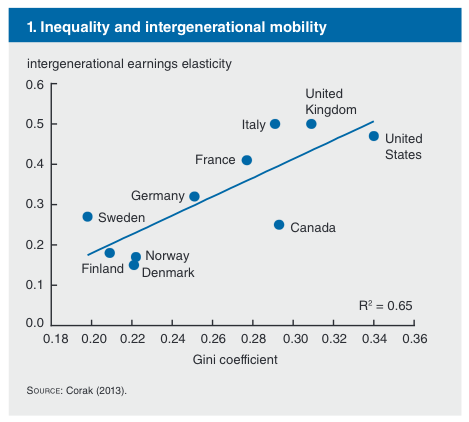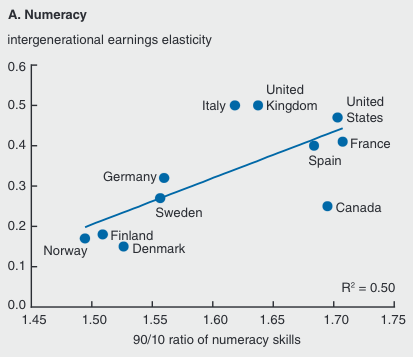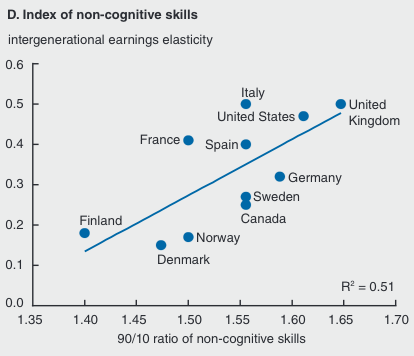One of my ongoing interests, piqued by the work of the University of Chicago's James Heckman (see my Q&A here), is on "non-cognitive" skills and their importance to education. For example, Heckman makes a compelling argument that, say, much of the value represented by a high school degree is the effort and process of getting it, not just the body of knowledge obtained that it represents. For Heckman, the GED is a natural (and unfortunate) test of the question—broadly speaking, GED recipients fare about as well as high-school dropouts, even though they've theoretically mastered enough of the curriculum to get the equivalent diploma.
So I was interested to see a new Chicago Fed Letter by Bhashkar Mazumder: "Inequality in skills and the Great Gatsby curve." You might have seen this curve before, about the relationship between income inequality and intergenerational mobility: more of one, more of the other, generally.
Mazumder takes an interesting angle on this, examining inequality of skills (cognitive and non-cognitive) and generational mobility. And his conclusions are notable:
In particular, I find that inequality in an index of “non-cognitive skills” explains as much or more of the variation in intergenerational mobility than inequality in traditional measures of cognitive skills such as numeracy, literacy, and problem solving. An emerging line of research has argued that personality traits such as perseverance and grit play an important role in socioeconomic success. These results are consistent with the idea that the large gaps in skills in the U.S. population are part of what is driving both higher inequality and lower intergenerational mobility.
Not surprising perhaps, but striking. Mazumder uses relatively new data from the Organisation for Economic Co-operation and Development (OECD) to investigate the skills of adults in 24 OECD countries to show how those with the most skills compare to those with the least. The U.S. comes in with the second-highest skills inequality in numeracy, problem-solving, and non-cognitive skills; in literacy (which the U.S. fares better in generally, compared to its peers, being just very slightly below average), we're closer to the middle of the pack.
Just to set the scene, here's the Gatsby curve:

Higher elasticity = lower mobility: "For example, an IGE of 0.4 implies that a 10% increase in parental income is associated with a 4% increase in child's income." Higher Gini coefficient = higher inequality.
The Gatsby curve for numeracy:

And the steeper slope for non-cognitive skills:

If you dive into the OECD numbers that Mazumder is using, you can see where the U.S. differs from other countries. The U.S. is one point ahead the OECD average for mean literacy score for tertiary education (including college); for “below upper secondary,” something like a high-school dropout, the U.S. is 16 points below the OECD average. For numeracy, the U.S. is nine points below and 33 points below, respectively.
For skilled occupations, the U.S. literacy score is two points below the OECD average; the numeracy score is 11 points below. For elementary occupations, by contrast, the U.S. is 11 points and 22 points below the OECD average.
Looking at other breakdowns, another interesting pattern emerges. The mean literacy score for American 55-65 year-olds is higher than the OECD average, 263 to 255. The mean literacy score for American 16-24 year-olds is higher than the national average for boomers, at 272, but lower than their OECD average for that age group, which is 280.
In numeracy, our boomers are just slightly below average (247 vs. 253), but our Millennials are well below average (249 vs. 271).
For problem-solving in "technology-rich environments," the portrait is the same: far more Millennials score highly than boomers, but the U.S. score for Millennials is much lower.
Altogether, it suggests an educational system (and other influences) that hasn't failed, per se, but a country that has not kept pace with its peers in its improvements.
And if you look at the charts above and in Mazumder's paper, you'll find that an outlier on the other end is Finland. But it hasn't always been such an outlier. The country used to have much larger achievement gaps, but 40 years ago the country began completely remaking its public educational system. Testing was de-emphasized and control of the curriculum dispersed to the local level; non-cognitive skills, including vocational ones, were emphasized:
We offer a variety of subjects during the school day. We’re also testing out what it’s like to have breaks in the middle of the school day for elementary school students. At a few elementary schools recently we’ve been offering sports, handcrafts, or school clubs during the middle of the school day, rather than just in the morning or after school as we already do. This is to help kids to think of something else, and do something different and more creative during the day.
It sounds like a contrast to the technocratic present of American education. But it was the planned cornerstone to the country's economic renewal, and if the rhetoric doesn't center on a results-oriented approach, it's producing results.



